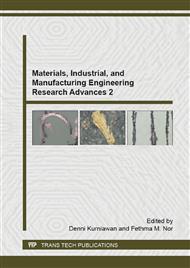p.306
p.312
p.317
p.322
p.327
p.332
p.337
p.345
p.350
An Investigation of Carbon Dioxide Sequestration on Amine–Modified Kenaf: Adsorption Isotherm Study
Abstract:
The increase concentration of CO2 in the atmosphere is linked with global climate change. Among the technology options used for CO2 capture, there is a growing interest in using adsorption method for separation process. Inspired by the most applicable technology of amine–based chemical absorption for capturing CO2, the development of amine–functionalized kenaf based adsorbent has been proposed in this study. The incorporation of amine functional group (MEA and TEPA) on kenaf was conducted via wet impregnation method. The characterization was carried out by using FESEM and FTIR. The CO2 adsorption equilibrium study have been conducted and further described by Langmuir and Freundlich isotherm equation models at temperature of 0, 25 and 50oC. Result presented shows that Freundlich isotherm model fits the experimental data for raw kenaf and amine–modified kenaf. It was indicated by the values of R2. Additionally, results for each sample show the adsorption favourability since the values of KL is less than 1 and the magnitude of Freundlich (n) is greater than 1. Finally, this study revealed that the amine–modified kenaf could become another potential adsorbent for CO2 separation.
Info:
Periodical:
Pages:
327-331
Citation:
Online since:
October 2015
Authors:
Keywords:
Price:
Сopyright:
© 2015 Trans Tech Publications Ltd. All Rights Reserved
Share:
Citation:


